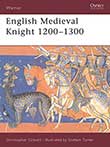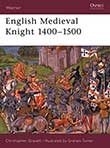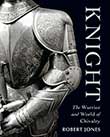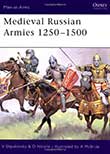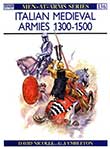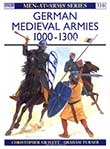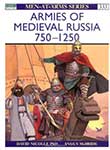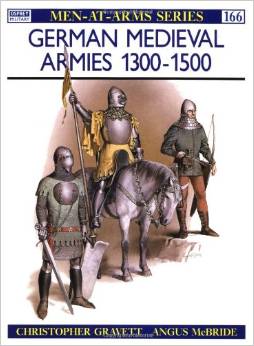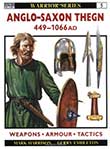

The 13th century was a time of change for knights in England. They were faced with rising costs and increasing demands on their time for local government because of their very status in society, until knighthood itself was sometimes avoided. This period saw as well the development of the tournament from the wild team events of the early years of the century to the single jousts with blunt lance. Campaign life in the 13th century also embraced several theatres of war including the baronial revolt against King John, the Barons' Wars of Simon de Montfort (also known as the Second Barons' War, (1264–1267)), and the Welsh and Scottish wars of Edward I. This title also covers the use and development of arms, armour, costume and other equipment.
The 15th century was a time of change for knighthood. Knights no longer fought for their lords in return for land, since the feudal summons had long before given way to a system of contracts. Moreover, many knights now preferred the role of landowner, man-about-town or parliamentary representative. However, this was also the age of the knight in plate armour, of the battle of Agincourt and the conquests of Henry V, and of the Wars of the Roses, the bloody internecine struggle that tore medieval England apart. In this title Christopher Gravett describes the life of a 15th century knight, his equipment and experiences from his earliest days as a squire through to his experiences on the battlefields of England and France.
From a life-long student of the medieval long sword and medieval history comes a comprehensive overview of the Age of the Knights. Jones shows that behind the popular image of the knight in shining armor lies a world that is both more complex and more fascinating. Were knights glory-seeking, bloodthirsty thugs that lay ravage to the Holy Land or simple Christians serving their king? Jones explores the myths and controversies behind their battle-effectiveness and chivalric code. He also examines knighthood as a "career path" and investigates the role of the knight in law and justice. Lavishly illustrated and drawing on rare first-hand accounts, this book reveals the world of the knight in all its tarnished glory.
After disastrous defeats at the hands of the Mongols in the 13th century, the Russian principalities became vassals of the Khans of the Golden Horde for more than 200 years; and at the same time the western princes faced the German crusaders of the Teutonic Order. Remarkably, Russia responded with a new surge of military vigour. Eventually, freedom from the 'Mongol yoke' coincided with a degree of unity around a powerful new state - Muscovy. This exciting chapter of history is illustrated with rare early paintings, photos, diagrams, and eight plates reconstructing the mixed influences of East and West in the appearance of Russian warriors.
Mercenaries were a common feature throughout most of Europe in the 14th and 15th centuries, and had been known far earlier. But nowhere did such a sophisticated system of hiring, payment and organisation of mercenaries develop as it did in Italy. The condottiere – whose name came from the condotta or contract between himself and his employer – was the result. Whether commander or humble trooper, the condottiere was a complete professional. His skill has never been doubted, but his loyalty and dedication to a particular cause often has. David Nicolle provides a fascinating exploration of the condottiere; his roles, arms and equipment.
In medieval Germany violence was accepted far more than in other kingdoms. Kings were recognised as guardians of order, but this had its limitations. Lords expected to use force to secure their rights or win an argument when peaceful methods were not sufficient. Christopher Gravett does a fine job of examining the organisation and campaigns of German medieval armies from 1000-1300, in a volume containing plenty of photographs and illustrations, including eight full page colour plates by Graham Turner.
In the centuries following the first expeditions down the great rivers of northern Russia by Viking traders and adventurers, the foundations for a new state were laid. Many influences combined in this colourful culture which grew up first around the great cities of Kiev and Novgorod – Scandinavian, Finnish, Slav, steppe Turkish, Byzantine. By the time of the Mongol invasions of the 12th century the small enclaves of the old pagan Rus’, tolerated by the Khazar Khans for their commercial usefulness, had evolved into a Christian nation. Its story is told here in fascinating detail, and illustrated with striking colour reconstructions of the warriors themselves.
The German rulers were forceful and powerful men, and, surrounded by potential enemies, circumstances dictated the necessity of rule by strength based on military capacity. In the later 15th Century, three houses rose above the others; the families of Wittelsbach, Luxemburg and the powerful Austrian Hapsburgs. The struggles of these and other houses, and of the knights and towns, were to be a feature of German history throughout the Middle Ages. This title details the dress, weapons, heraldry and insignia of these prolific forces, as well as various battles, such as the Battle of Goellheim of 1298.
The collapse of Roman rule in Britain was not so much a sudden catastrophe as a long and drawn-out decline. The 'Celtic' Britons retreated gradually to the highland areas of Wales, Cornwall and the south-west of Scotland. Control of the fertile eastern lowlands was lost to warriors of Germanic origin who migrated from the Continent. These Germanic conquerors have become known to history as the 'Anglo-Saxons'. They were to dominate the lowland zone of Britain until their final defeat at Hastings in 1066. This title gives an insight into the everyday life, equipment, dress, battle tactics and life on campaign of the typical Anglo-Saxon warrior of this period – the thegn.
St. Felix I ends his reign as Catholic Pope
French King Hugo Capet crowns his son Robert the compassionate King
Pontifical degree "Sancta Romania" against spiritualists
English King James I cracks Protestation of Parliament
"Messiah" Sjabtai Tswi departs to Constantinople
Abraham Crijnssen departs to Suriname
Baron Karl Rabenhaupt occupies Coevorden Neth
Don Francisco de Agurto installed as land guardian of S Netherlands
Henry Purcell and Tates opera "Dido and Aeneas, " premieres in Chesea
Tokyo hit by Earthquake; about 37,000 die
French troops conquer Grave Neth
Wearing masks at balls forbidden in Boston
Danzig surrenders to allied armies
1st coffee planted in Hawaii (Kona)
After gold discovery in Ga, Cherokees forced to move across Miss R
HMS Beagle / Charles Darwin sails from New Zealand to Sydney
Lehman-theater in St. Petersburg catches fire; 100s die
Opera "Stradella" after being rewritten is produced (Hamburg)
Pennsylvania Rock Oil Co, 1st in US, incorporated in New York City
US, banks stops payments in gold
Philadelphia Knights of Labor forms
American Metrological Society forms (NYC) weights, measures and money
Andrassy Note calls for Christian-Muslim religious freedoms
Belgium: King Leopold II installs Order of African Star
Dr Miles V Lynk, physician, publishes 1st Black medical journal
Russia signs military accord with France
Stanley Cup: Montreal Victorias beat Winnipeg Victorias, 6-5
Province of Zululand annexed to Natal colony
American Political Science Association founded at New Orleans
Iran becomes a constitutional monarchy
Stanley Cup: Mont Wanderers outscore Edmonton, 13-10 in 2 game set
Sun Yat-sen elected 1st President of the Republic of China
Barnes takes 17 wickets vs. South Africa (8-56 & 9-103)
Cromarty Harbour, Scot-British cruiser Natal explodes: 405 die
John E Hoover decides to be called J Edgar Hoover
Soviet Union organized as a federation of RSFSR, Ukrainian SSR, Belorussian SSR and Transcaucasian SSR
Edwin Hubble announces existence of other galactic systems
New South Wales score 705 against Victoria, go from 8-475 to 9-701
Chicago Tribune reports the Tigers threw a 4-game series to the White Sox in 1917 to help Chicago win the pennant (never substaniated)
Japan dedicates 1st subway in Orient (route under 2 miles long)
Sigma Gamma Rho Sorority incorporates
Government disallows NSB-membership for civil service
Italian bombers destroy Swedish Red Cross unit in Ethiopia
United Auto Workers stage 1st sit-down strike, at Fisher Body Plant
Electronic television system patented (V K Zworykin)
Nazibezetters oblige artsen member to become of Artsenkamer
Nazis require Dutch physicians to join Nazi organization
Winston Churchill addresses Canadian parliament
Phillies trade Babe Dahlgren to Pittsburgh for Babe Phelps and cash
King George II of Greece, abdicates his throne
36th Davis Cup: USA beats Australia in New York (4-1)
King Michael of Romania, forced by communists abdicates his throne
Romanian Republic proclaimed
"Kiss Me, Kate" opens at New Century Theater NYC for 1077 performances
Vietnam, Laos and Cambodia become Independent states in France Union
Tuskegee Institute reports 1952 as 1st yr in 71 with no lynchings in US
"House of Flowers" opens at Alvin Theater NYC for 165 performances
1st use of 24-sec shot clock in pro basketball (Rochester vs. Boston)
Harold Arlen / Truman Capotes musical premieres in New York City
New York Giants beat Chicago Bears 47-7 in NFL championship game
Israeli government of Ben-Gurion, resigns
New York Giants win NFL championship
George Washington, 1st ballistic missile sub commissioned
Green Bay Packers beat the New York Giants 16-7 in NFL championship game
Congress authorizes Kennedy half dollar
Green Bay Packers win NFL championship
Ferdinand Marcos inaugurated as President of the Phillipines
Great Western Forum opens in LA
Paul McCartney sues his bandmates to dissolve the Beatles
Long Island NHL franchise purchased (NY Islanders)
President Nixon halts bombing of North Vietnam and announces peace talks
1st picture of a comet from space (Comet Kohoutek-Skylab)
Miami Dolphins beat Oakland Raiders 27-10 in AFC championship game
Minnesota Vikings beat Dallas Cowboys 27-10 in NFC championship game
Beatles are legally disbanded (4 years after suit was brought)
"Boccaccio" closes at Edison Theater NYC after 7 performances
Constitution of Democratic Republic of Madagascar comes into force
Carter holds 1st news conference by US President in Eastern Europe (Warsaw)
"King & I" closes at Uris Theater NYC after 719 performances
Ohio State dismisses Woody Hayes as its football coach
Rock group, Emerson, Lake and Palmer break up
Togo adopts constitution
"Wonderful World of Disney, " last performance on NBC-TV
Wayne Gretzky sets NHL record of 50 goals by 39th game of season
Anthony Shaffers "Whodunnit, " premieres in New York City
US Assay Office in New York City, New York closes
Miss Elizabeth (Hulette) and Macho Man Randy Savage (Poffo) wed
IBM-PC DOS Version 3.2 released
Pakistan restores constitution
Australia hang on for draw vs. New Zealand at MCG, 1 wkt left 17 runs short
Premier Mugabe elected President of Zimbabwe
North subpoenas Reagan and Bush as defense witnesses for upcoming trial
10th United Negro College Fund raises $12,000,000
Dmitri Volkov swims world record 50m freestyle (27.15 seconds)
"Miser" closes at Circle in the Square Theater NYC after 93 performances
11th United Negro College Fund raises $10,000,000
Shane Warne takes 7-52 to lead Australian MCG win vs. West Indies
"Candles, Snow, and Mistletoe" closes at Palace NYC after 7 performances
Singer Deni Hines (22) weds INXS guitarist Kirk Pengilly (35)
Vatican recognizes Israel
Carquest Bowl 6: North Carolina beats Arkansas, 20-10
